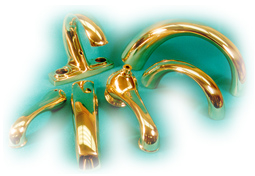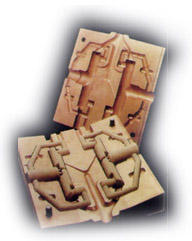Environmentally Friendly Permanent Mold Casting
Copper Applications in Innovative Technology
 Permanent mold castings have been available in the North American foundry industry for many years, but until recently, the permanent mold casting process has not been widely applied to copper alloys. The permanent mold casting of copper alloys is quite common in Asia, Europe and the United Kingdom, however, and it is rapidly gaining greater acceptance in North America as engineers and designers come to recognize its unique advantages.
Permanent mold castings have been available in the North American foundry industry for many years, but until recently, the permanent mold casting process has not been widely applied to copper alloys. The permanent mold casting of copper alloys is quite common in Asia, Europe and the United Kingdom, however, and it is rapidly gaining greater acceptance in North America as engineers and designers come to recognize its unique advantages.
As its name implies, the permanent mold casting method makes use of reusable metal molds, or dies, in place of the sand-base molds used in conventional foundries. The molds are "permanent" in the sense that they can be used thousands of times.
Permanent mold dies are constructed in sections that functionally resemble the cope and drag found in sand molds. The sections are clamped or hydraulically forced together to form a mold containing the die cavity. Two die sections normally suffice for simple-shaped products, whereas complex castings and those containing re-entrant angles may require multicomponent dies.
Sprues, runners and gating systems machined into the die sections feed molten metal to the die cavity, as shown in the figure at right. Air relief risers and overflow cavities may be included as well. Baked sand cores can be placed in the die cavities to form internal structures in the finished castings. Several die cavities are often combined in a single mold to maximize productivity.
The permanent mold (PM) casting method is clean. It produces very little waste and almost no fumes. All scrap and excess metal from gates and runners is recycled to the furnace. Most important, the process avoids almost all of the contamination problems that sand foundries must deal with.
 The PM casting process can accommodate many of the standard copper alloys, although metallurgical factors favor some compositions over others. An alloy's casting properties are obviously important, just as they are in the case of sand castings. On the other hand, some of the most common sand casting alloys are not well suited to the permanent mold process.
The PM casting process can accommodate many of the standard copper alloys, although metallurgical factors favor some compositions over others. An alloy's casting properties are obviously important, just as they are in the case of sand castings. On the other hand, some of the most common sand casting alloys are not well suited to the permanent mold process.
One or at most two properties normally dictate the choice of alloy for technical products. In the case of copper alloys, the properties cited most often are conductivity and corrosion resistance. High strength, when it is called for, is usually required in combination with one or both of these attributes. Material selection always involves compromise, but copper alloys are unique in that they offer a favorable combination of conductivity, corrosion resistance and mechanical properties not found in other engineering materials.
Permanent mold cast copper alloys can be as strong or stronger than sand-cast gray iron and austenitic stainless steel, materials with which copper alloys frequently compete. It is generally true that permanent mold castings have equivalent or better strength and ductility compared to sand castings due to rapid cooling and the resulting fine grain structure.
Yellow brasses resist corrosion in clean fresh waters, although certain aggressive waters can lead to selective removal of zinc from the alloy composition, a process known as dezincification. Dezincification can be avoided by applying cathodic protection, but it is more often prevented or at least significantly reduced by adding tin, phosphorus or antimony to the alloy's composition. Several European plumbing brasses are based on compositions containing these elements. Some European alloys contain arsenic, which also inhibits dezincification (Arsenic is not used in North American alloys). Comparable compositions are also recognized by the Copper Development Association Inc. and are listed as UNS alloys. In addition, several permanent mold foundries offer proprietary modifications of standard plumbing alloys for use in aggressive waters.
Most permanent mold casting alloys contain significantly less lead than standard casting alloys; many are lead-free. Low or zero lead content makes permanent mold casting alloys attractive candidates for plumbing goods. Lead-free or low-lead yellow brasses are widely used for such products in Europe and England and their use is growing in North America. Dezincification, which can occur when brasses are exposed to aggressive waters, is avoided by including small amounts of tin, antimony or phosphorus in the alloys' compositions. Silicon brasses are increasingly being used for plumbing products in the United States.
A relatively recent development has been the introduction of several lead-free yellow plumbing brasses modified by the addition of bismuth and/or bismuth plus selenium. These elements, especially when used in combination, promote the sort of high machinability and pressure tightness usually associated with leaded brasses. Lead-free bismuth-selenium plumbing brasses, as well as some reduced-lead yellow brasses, are designed to pass the stringent low lead leaching requirements contained in NSF Standard 61.
SeBiLOY III (C89550)
SeBiLOY III is a selenium-bismuth containing yellow brass specifically developed for the permanent mold casting process. SeBiLOY III was designed as a lead-free, free-machining brass for potable water applications such as faucets and other plumbing fixtures. Bismuth in combination with selenium improves machinability of yellow brass. However, in this yellow brass, the bismuth content should be kept below 1.0% to avoid hot tearing as well as improve fluidity. The addition of zirconium improves both of these casting properties as well as aiding in grain refinement. SeBiLOY III exhibits improved mechanical properties and corrosion resistance. The strength of SeBiLOY III exceeds that for leaded yellow brass.
When an existing sand casting is quoted as a permanent mold casting, the as-cast sand casting will be less expensive almost every time. However, by redesigning the product to take advantage of improved mechanical properties and other advantages of the permanent mold method, a casting can often be produced for significantly lower overall cost than the original sand casting. Permanent mold castings can be made with thinner sections, thereby saving metal; closer tolerances and the ability to cast small-diameter holes can reduce or eliminate finish-machining operations.
Also in this Issue:
- New Copper Alloys: Revised and Reactivated Alloy Compositions
- New Copper Alloys: Compositions of New Copper Alloys
- New Copper Alloys
- ARI and CDA Sponsor Research on Copper Joining Techniques with Future Refrigerants
- The Butte Copper Mines
- Paul Revere - Copper Industry Pioneer
- The History of Brass Making in the Naugatuck Valley
- Environmentally Friendly Permanent Mold Casting
